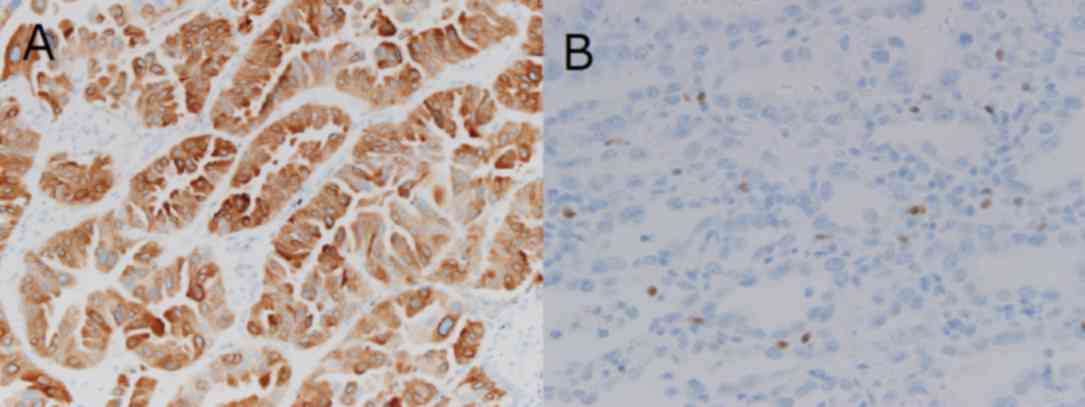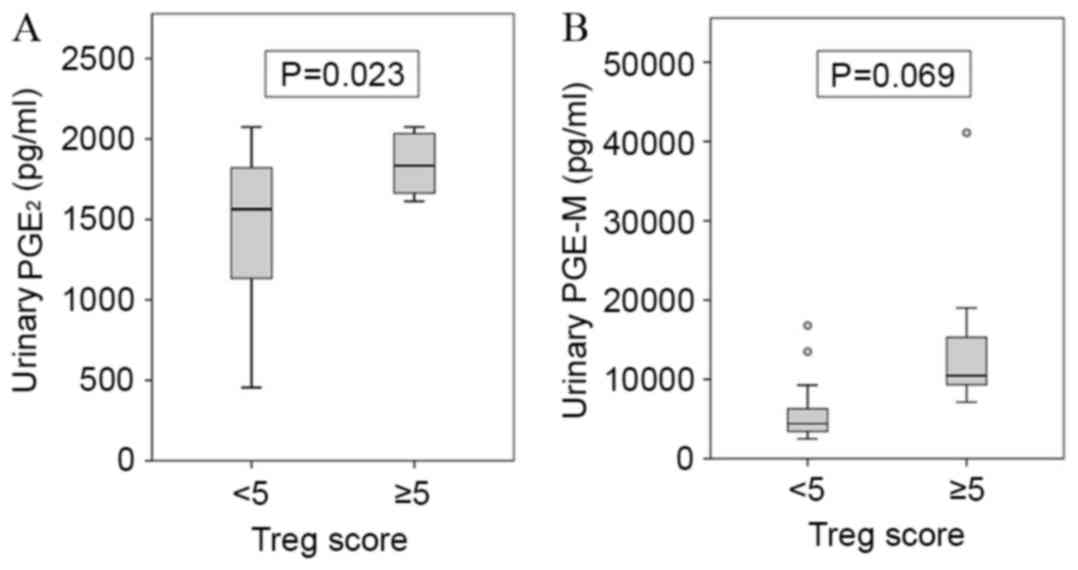|
1
|
Asamura H, Goya T, Koshiishi Y, Sohara Y,
Eguchi K, Mori M, Nakanishi Y, Tsuchiya R, Shimokata K, Inoue H, et
al: A Japanese lung cancer registry study: Prognosis of 13,010
resected lung cancers. J Thorac Oncol. 3:46–52. 2008. View Article : Google Scholar : PubMed/NCBI
|
|
2
|
Sawabata N, Miyaoka E, Asamura H,
Nakanishi Y, Eguchi K, Mori M, Nomori H, Fujii Y, Okumura M and
Yokoi K: Japanese Joint Committee for Lung Cancer Registration:
Japanese lung cancer registry study of 11,663 surgical cases in
2004: Demographic and prognosis changes over decade. J Thorac
Oncol. 6:1229–1235. 2011. View Article : Google Scholar : PubMed/NCBI
|
|
3
|
Shimizu K, Okita R and Nakata M: Clinical
significance of the tumor microenvironment in non-small cell lung
cancer. Ann Transl Med. 1:202013.PubMed/NCBI
|
|
4
|
Dieu-Nosjean MC, Antoine M, Danel C,
Heudes D, Wislez M, Poulot V, Rabbe N, Laurans L, Tartour E, de
Chaisemartin L, et al: Long-term survival for patients with
non-small-cell lung cancer with intratumoral lymphoid structures. J
Clin Oncol. 26:4410–4417. 2008. View Article : Google Scholar : PubMed/NCBI
|
|
5
|
Al-Shibli K, Al-Saad S, Donnem T, Persson
M, Bremnes RM and Busund LT: The prognostic value of
intraepithelial and stromal innate immune system cells in non-small
cell lung carcinoma. Histopathology. 55:301–312. 2009. View Article : Google Scholar : PubMed/NCBI
|
|
6
|
Dai F, Liu L, Che G, Yu N, Pu Q, Zhang S,
Ma J, Ma L and You Z: The number and microlocalization of
tumor-associated immune cells are associated with patient's
survival time in non-small cell lung cancer. BMC Cancer.
10:2202010. View Article : Google Scholar : PubMed/NCBI
|
|
7
|
Takanami I, Takeuchi K and Naruke M: Mast
cell density is associated with angiogenesis and poor prognosis in
pulmonary adenocarcinoma. Cancer. 88:2686–2692. 2000. View Article : Google Scholar : PubMed/NCBI
|
|
8
|
Al-Shibli KI, Donnem T, Al-Saad S, Persson
M, Bremnes RM and Busund LT: Prognostic effect of epithelial and
stromal lymphocyte infiltration in non-small cell lung cancer. Clin
Cancer Res. 14:5220–5227. 2008. View Article : Google Scholar : PubMed/NCBI
|
|
9
|
Wakabayashi O, Yamazaki K, Oizumi S,
Hommura F, Kinoshita I, Ogura S, Dosaka-Akita H and Nishimura M:
CD4+ T cells in cancer stroma, not CD8+ T cells in cancer cell
nests, are associated with favorable prognosis in human non-small
cell lung cancers. Cancer Sci. 94:1003–1009. 2003. View Article : Google Scholar : PubMed/NCBI
|
|
10
|
Shimizu K, Nakata M, Hirami Y, Yukawa K,
Maeda A and Tanemoto K: Tumor-infiltrating Foxp3+ regulatory T
cells are correlated with cyclooxygenese-2 expression and are
associated with recurrence in resected non-small cell lung cancer.
J Thorac Oncol. 5:585–590. 2010. View Article : Google Scholar : PubMed/NCBI
|
|
11
|
Ferretti A, Flanagan VP and Roman JM:
Quantitative analysis of 11
alpha-hydroxy-9,15-dioxo-2,3,4,5,20-pentanor-19-carboxyprostanoic
acid, the major urinary metabolite of E prostaglandins in man. Anal
Biochem. 128:351–358. 1983. View Article : Google Scholar : PubMed/NCBI
|
|
12
|
Wang D and DuBois RN: Urinary PGE-M: A
promising cancer biomarker. Cancer Prev Res (Phila). 6:507–510.
2013. View Article : Google Scholar : PubMed/NCBI
|
|
13
|
Cai Q, Gao YT, Chow WH, Shu XO, Yang G, Ji
BT, Wen W, Rothman N, Li HL, Morrow JD and Zheng W: Prospective
study of urinary prostaglandin E2 metabolite and colorectal cancer
risk. J Clin Oncol. 24:5010–5016. 2006. View Article : Google Scholar : PubMed/NCBI
|
|
14
|
Dong LM, Shu XO, Gao YT, Milne G, Ji BT,
Yang G, Li HL, Rothman N, Zheng W, Chow WH and Abnet CC: Urinary
prostaglandin E2 metabolite and gastric cancer risk in the Shanghai
women's health study. Cancer Epidemiol Biomarkers Prev.
18:3075–3078. 2009. View Article : Google Scholar : PubMed/NCBI
|
|
15
|
Goldstraw P, Crowley J, Chansky K, Giroux
DJ, Groome PA, Rami-Porta R, Postmus PE, Rusch V and Sobin L:
International Association for the Study of Lung Cancer
International Staging Committee; Participating Institutions: The
IASLC lung cancer staging project: Proposals for the revision of
the TNM stage groupings in the forthcoming (seventh) edition of the
TNM Classification of malignant tumours. J Thorac Oncol. 2:706–714.
2007. View Article : Google Scholar : PubMed/NCBI
|
|
16
|
Edelman MJ, Watson D, Wang X, Morrison C,
Kratzke RA, Jewell S, Hodgson L, Mauer AM, Gajra A, Masters GA, et
al: Eicosanoid modulation in advanced lung cancer: Cyclooxygenase-2
expression is a positive predictive factor for celecoxib+
chemotherapy -cancer and leukemia group B trial 30203. J Clin
Oncol. 26:848–855. 2008. View Article : Google Scholar : PubMed/NCBI
|
|
17
|
Perrone G, Ruffini PA, Catalano V, Spino
C, Santini D, Muretto P, Spoto C, Zingaretti C, Sisti V,
Alessandroni P, et al: Intratimoural FOXP3-positive regulatory T
cells are associated with adverse prognosis in radically resected
gastric cancer. Eur J Cancer. 44:1875–1882. 2008. View Article : Google Scholar : PubMed/NCBI
|
|
18
|
Curiel TJ: Tregs and rethinking cancer
immunotherapy. J Clin Invest. 117:1167–1174. 2007. View Article : Google Scholar : PubMed/NCBI
|
|
19
|
Kim JM and Rudensky A: The role of the
transcription factor Foxp3 in the development of regulatory T
cells. Immunol Rev. 212:86–98. 2006. View Article : Google Scholar : PubMed/NCBI
|
|
20
|
Hori S, Nomura T and Sakaguchi S: Control
of regulatory T cell development by the transcription factor Foxp3.
Science. 299:1057–1061. 2003. View Article : Google Scholar : PubMed/NCBI
|
|
21
|
Petersen RP, Campa MJ, Sperlazza J, Conlon
D, Joshi MB, Harpole DH Jr and Patz EF Jr: Tumor infiltrating
Foxp3+ regulatory T-cells are associated with reccurence in
pathologic stage l NSCLC patients. Cancer. 107:2866–2872. 2006.
View Article : Google Scholar : PubMed/NCBI
|
|
22
|
Sharma S, Yang SC, Zhu L, Reckamp K,
Gardner B, Baratelli F, Huang M, Batra RK and Dubinett SM: Tumor
cyclooxygenase-2/prostaglandin E2-dependent promotion of FOXP3
expression and CD4+CD25+ T regulatory cell activities in lung
cancer. Cancer Res. 65:5211–5220. 2005. View Article : Google Scholar : PubMed/NCBI
|
|
23
|
Wang D and Dubois RN: Eicosanoids and
cancer. Nat Rev Cancer. 10:181–193. 2010. View Article : Google Scholar : PubMed/NCBI
|
|
24
|
Morris PG, Zhou XK, Milne GL, Goldstein D,
Hawks LC, Dang CT, Modi S, Fornier MN, Hudis CA and Dannenberg AJ:
Increased levels of urinary PGE-M, a biomarker of inflammation,
occur in association with obesity, aging and lung metastases in
patients with breast cancer. Cancer Prev Res (Philla). 6:428–436.
2013. View Article : Google Scholar
|
|
25
|
Murphey LJ, Williams MK, Sanchez SC, Byrne
LM, Csiki I, Oates JA, Johnson DH and Morrow JD: Quantification of
the major urinary metabolite of PGE2 by a liquid
chromatographic/mass spectrometric assay: Determination of
cyclooxygenase-specific PGE2 synthesis in healthy humans and those
with lung cancer. Anal Biochem. 334:266–275. 2004. View Article : Google Scholar : PubMed/NCBI
|
|
26
|
Mutter R, Lu B, Carbone DP, Csiki I,
Moretti L, Johnson DH, Morrow JD, Sandler AB, Shyr Y, Ye F and Choy
H: A phase II study of celecoxib in combination with paclitaxel,
carboplatin and radiotherapy for patients with inoperable stage
IIIA/B non-small cell lung cancer. Clin Cancer Res. 15:2158–2165.
2009. View Article : Google Scholar : PubMed/NCBI
|
|
27
|
Csiki I, Morrow JD, Sandler A, Shyr Y,
Oates J, Williams MK, Dang T, Carbone DP and Johnson DH: Targeting
cyclooygenase-2 in recurrent non-small cell lung cancer: A phase II
trial of celecoxib and docetaxel. Clin Cancer Res. 11:6634–6640.
2005. View Article : Google Scholar : PubMed/NCBI
|
|
28
|
Kurose K, Ohue Y, Sato E, Yamauchi A,
Eikawa S, Isobe M, Nishio Y, Uenaka A, Oka M and Nakayama E:
Increase in activated Treg in TIL in lung cancer and in vitro
depletion of Treg by ADCC using an antihuman CCR4 mAb (KM2760). J
Thorac Oncol. 10:74–83. 2015. View Article : Google Scholar : PubMed/NCBI
|
|
29
|
Zhang X, Miao X, Tan W, Ning B, Liu Z,
Hong Y, Song W, Guo Y, Zhang X, Shen Y, et al: Identification of
functional genetic variants in cyclooxygenase-2 and their
association with risk of esophageal cancer. Gastroenterology.
129:565–576. 2005. View Article : Google Scholar : PubMed/NCBI
|
|
30
|
Yukawa T, Shimizu K, Maeda A, Yasuda K,
Saisho S, Okita R and Nakata M: Cyclooxygenaze-2 genetic variants
influence intratumoral infiltration of FoxP3-positive regulatory T
cells in non-small cell lung cancer. Oncol Rep. 33:74–80.
2015.PubMed/NCBI
|











